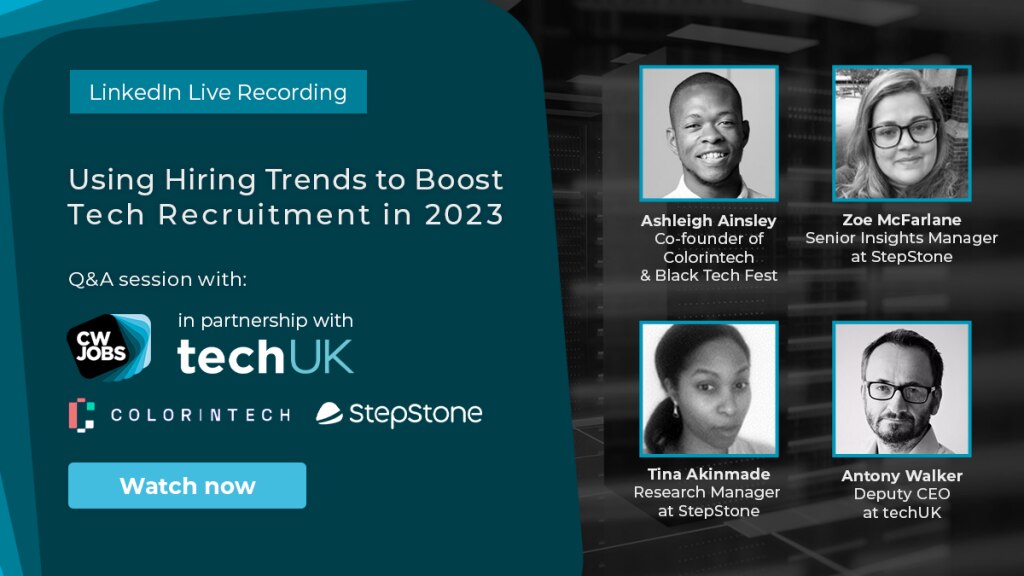Tech hiring trends to attract and retain talent
CWJobs’ LinkedIn Live webinar explores the latest tech hiring trends and how companies can use them to boost their candidate attraction and employee retention strategies.

Our Commercial Director, Dominic Harvey recently hosted a panel discussion on the latest hiring trends in the UK tech industry. He was joined by Ashleigh Ainsley, Co-founder of Colorintech and Black Tech Fest; Zoë McFarlane, Senior Insights Manager at StepStone; Tina Akinmade, Research Manager at StepStone; and Antony Walker, Deputy CEO at techUK.
Here are some of the key highlights from the webinar:
Key trends in tech recruitment
Zoë began the discussion by sharing some insights from CWJobs’ Tech Talent Trends and Expectations report, which reveal that 60% of tech workers are open to opportunities, or are actively job hunting.
The research also finds that one in five (20%) tech workers wouldn’t bother applying for a job if they didn’t have more than three quarters of the requirements in the job advert. Zoë said:
‘‘The more requirements employers put in a role, the more they’re limiting the number of people who will apply. Candidate tolerance for having to meet strict requirements is relatively low and an increasing number of people simply don’t want to enter a role where they don’t have those skills.’’
Strong demand for IT and digital talent
Antony added that big tech companies are reversing the intense hiring that has been seen throughout the pandemic. However, despite what the media often reports, there’s a strong demand for IT and digital talent right across the economy. He said that tech talent is being quickly absorbed across the industry, which will foster new innovation and growth.
In turn, this means that tech talent can afford to think about the security that companies are offering. They also want to know that potential employers care about the same things they do.
Zoë added that candidates know their worth and they’re more willing to hold out for the right opportunity.
Considering the candidate journey
Every stage in the jobseeker journey is an opportunity for candidates to review their fit for a role, so companies need to invest in the candidate experience. Tina said:
‘‘Employers that only consider what candidates need at the point of application are losing out on attracting passive candidates. We need to think about the individual steps in a candidate’s journey and the activities that go along with them.
Both active and passive candidates are keeping their eyes on opportunities and checking out company profiles. So, with a single advert, employers need to cater for both types of candidates who are considering things like company culture, daily activities, and the technology they’ll be using in the role.’’
Zoë added that research from BGC reveals that 52% of candidates would refuse a job offer if they didn’t enjoy the recruitment process – even if the role offered the benefits they wanted and they fit the skills profile.
Frustrations for senior tech workers
CWJobs’ research finds that the top frustrations for senior tech workers are not having enough time to upskill (30%), too many processes (26%), not having enough budget (22%).
Whereas the top support mechanisms that senior tech workers expect from their employers are performance feedback (39%), career coaching (42%), and mental health support (40%). Antony said:
‘‘It’s not surprising that upskilling matters to senior tech workers because they’ve been around for a while and they understand how technology moves. For them to stay relevant in a constantly evolving market, they need the necessary skills. When they’re in roles with no upskilling opportunities, they question what it’s doing to their overall value in the labour market.’’
The need for transparency in the recruitment process
Zoë shared an insight from CWJobs’ Tech Talent Trends report, which reveals that 43% of tech workers have dropped out of a job application because the recruitment process was too slow. On average, candidates expect to participate in two interviews and for the recruitment process to take two or three weeks. Antony said:
‘‘For a small company, condensing the recruitment process into two or three weeks is achievable. It’s easy to pick up the phone and make job offers, or provide feedback. But in a big company, sometimes it takes two to three weeks just to interview one person. Especially if there have been layoffs and cutbacks in recruitment teams. Being honest and upfront in job ads about the recruitment process goes a long way.’’
Tina added that it’s important for recruiters to be human and to engage with candidates empathetically. She said the process of applying for jobs can be overwhelming, and having information upfront lets candidates assess whether a role is right for them.
What to include in tech job adverts
Dominic shared that the most important pieces of information candidates expect to see in a job advert are salary (46%), location (34%), required skills (31%), employee benefits (30%), and working hours (29%).
Tina added that employers need to be specific about this information. If a role is in London, the advert needs to state exactly where in London candidates will be based. If an advert mentions flexible working, it needs to state what all the options are.
Whereas providing salary and location information can often be a tick box exercise for employers, what candidates are really looking for is clarity.
Watch the webinar in full, here.